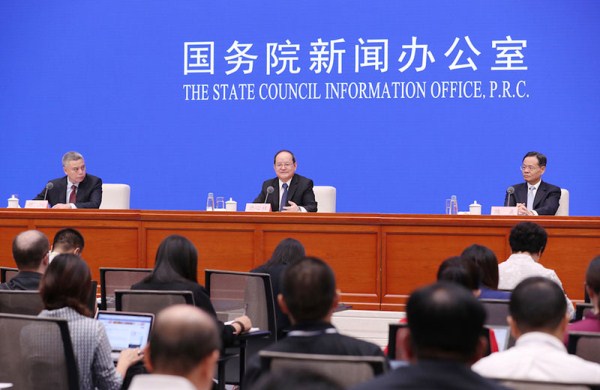Guangxi showcases 70 years of achievements

A press conference on 70 years of development in Guangxi Zhuang autonomous region is held in Beijing on Sept 2. [Photo by Huang Ke and Liang Kaichang/Guangxi Daily]
The State Council Information Office held a special press conference on the development of South China's Guangxi Zhuang autonomous region on Sept 2 to celebrate the 70th anniversary of the founding of the People's Republic of China.
Guangxi has undergone transformational changes over the past 70 years. The total GDP of Guangxi has increased from 2.45 billion yuan ($343.13 million) at the beginning of the autonomous region to more than 2 trillion yuan in 2018, with its per capita GDP exceeding $6,000. Guangxi now has 10 industries with a scale surpassing 100 billion yuan, such as food, automobiles, and machinery, of which the annual output of automobiles exceeds 2 million, which occupies an important position in the country.
The infrastructure in Guangxi has achieved rapid development. The mileage of high-speed rail trains reaches 1,771 kilometers to 12 cities in the region and all surrounding provinces. About 91 percent of the counties have access to expressways, and the annual throughput capacity of coastal and inland ports exceeds 250 million tons and 110 million tons respectively.
Guangxi is striving to promote the regional development of areas along the sea, river, and border. Since 2008, the regional GDP of the four cities in the Beibu Gulf Economic Zone has grown at an average annual rate of 11.5 percent, and the economic aggregate of the seven cities in the Xijiang Economic Belt reached 1.2 trillion yuan in 2018. Guangxi has continued to strengthen its opening up efforts with cooperation with ASEAN as the focus. It has successfully held 15 sessions of the China-ASEAN Expo and the China-ASEAN Business and Investment Summit.
Since the 18th CPC National Congress, Guangxi has promoted more than 1,400 major measures to press ahead with reform and innovation. A number of major reforms have made breakthroughs, such as administrative examination and approval, commercial and institutional systems, as well as fiscal and taxation systems.
From 2012 to 2018, Guangxi's reduced its impoverished population to 8.25 million, with an average annual poverty reduction of 1.17 million, and the incidence of poverty fell from 18 percent to 3.7 percent.
The region also has paid great attention to ecological environment protection, as the energy consumption per 10,000 yuan of GDP decreased by 24.1 percent from 2012 to 2018. In addition, the ratio of good air quality days in cities reached 91.6 percent in 2018. The vegetation ecological quality and vegetation ecological improvement also ranks first in the country.


